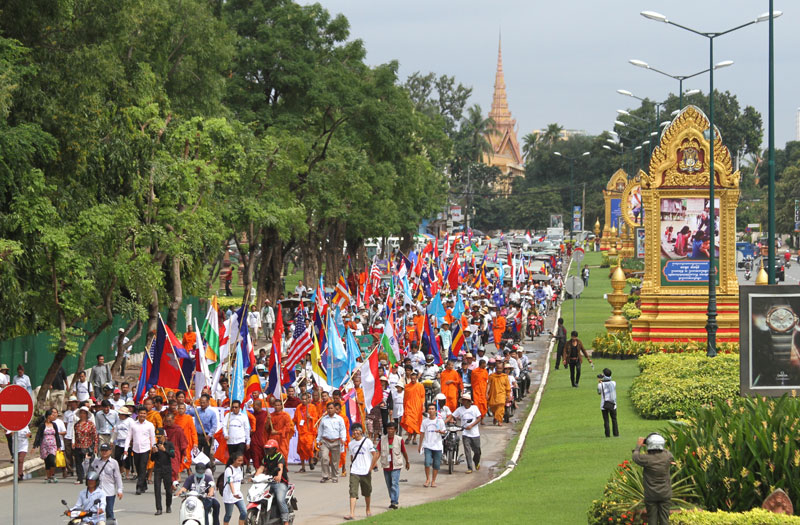On the 23rd anniversary of the day Prince Norodom Sihanouk and Prime Minister Hun Sen resolved to come together to end Cambodia’s civil war, celebrations on Thursday turned into an exhibition of the endurance of the political divisions forged during the two decades of conflict.
Prince Sihanouk and Mr. Hun Sen led their warring factions to sign the Paris Peace Agreements on October 23, 1991, paving the way for the dissolution of the Vietnamese-backed regime in Phnom Penh and the beginning of a liberal democracy with the U.N.-organized elections of 1993.

The agreement has long been criticized by Mr. Hun Sen’s CPP for failing to disarm the Khmer Rouge, and the ruling party removed its anniversary from the list of national holidays between 2004 and 2011 in order to promote January 7, 1979, as the day of liberation from Pol Pot’s regime.
At the CNRP’s headquarters in Phnom Penh’s Meanchey district on Thursday, CNRP Vice President Kem Sokha, who spent the 1980s as a covert member of Prince Sihanouk’s resistance coalition, described October 23 as the country’s true national day.
“There are many Cambodian historical days, but the day of October 23, 1991, is for all Cambodians,” Mr. Sokha told about 200 opposition supporters who turned out.
“March 18, 1970, is the historical day of Lon Nol and the Khmer Republic. April 17, 1975, is the victory of the Khmer Rouge and Pol Pot. And January 7 is the victory of the CPP and was in particular a victory of the yuon,” he said.
The word “yuon” is a Khmer-language term for Vietnamese that is considered by some to be derogatory. Its use was discouraged during the Vietnamese occupation of the country in the 1980s but remains in common parlance.
Mr. Sokha also used his speech Thursday to downplay Mr. Hun Sen’s role in the accord and instead credited leaders of the resistance.
“We all believe this day is important to commemorate our leaders who signed to bring about October 23, 1991, that is, King Norodom Sihanouk and Son Sann,” Mr. Sokha said, referring to the leader of his faction of the resistance.
Former Prime Minister Son Sann led the republican faction of the resistance on the Thai border and later founded the Buddhist Liberal Democracy Party (BLDP), for whom Mr. Sokha won his first National Assembly seat in 1993.
The BLDP collapsed in the 1990s, followed by the demise of Funcinpec in the 2000s, both due to internal divisions and collaboration with the ruling CPP. But former opposition elements from both parties regrouped to form the CNRP in July 2012.
Mr. Sokha said the peace agreement’s aim to reunite a divided country after decades of war remained unrealized and criticized the CPP for the failed reconciliation, describing Mr. Hun Sen’s “win-win” policy as a flop.
“They use the ‘win-win’ policy. What does this mean? It means those who win continue to win, and those who are defeated continue to be defeated,” Mr. Sokha said. “Now the strong violate the weak, those with power violate those without. This creates further suffering. It is not reconciliation.”
On the other side of Phnom Penh, opposition-aligned union leaders Vorn Pao and Rong Chhun led a march of about 1000 people from the French Embassy to the National Assembly, where a small group of lawmakers waited.
Climbing to the top of a tuk-tuk, Mr. Pao, who leads the country’s largest association of informal workers, read aloud the group’s petition, which accused the ruling party of failing to adhere to the spirit of the peace accord.
“The corruption and dependent courts have served the ruling party, resulting in dictatorship, and killing has taken place nationwide in Cambodia under the present government for more two decades,” Mr. Pao shouted over a loudspeaker.
CPP lawmaker Lork Kheng and CNRP lawmaker Ho Vann were then given a chance to respond to the group.
Over the loudspeaker, Mr. Vann delivered a speech informing the crowd that he hoped to use his position in the assembly to better implement the 1991 Peace Agreement.
To the crowd’s surprise, Ms. Kheng then began mirroring much of what Mr. Vann said, before suddenly shifting.
“Brothers and sisters have told me not to remind them about January 7 and therefore I won’t remind you that it was our second birth,” Ms. Kheng shouted the crowd, who began jeering and moving in on the ruling-party lawmaker.
“There was January 7, and therefore there could be October 23, the day that we got multi-party democracy and the day all parties united as one Khmer nation,” she said.
Not backing down, and with a growing smile, Ms. Kheng then cautioned the raucous crowd to recall that the 1991 accord had recognized the legitimacy of the Khmer Rouge, who were not disarmed until 1999.
“Although there was October 23, our country still did not get peace, security and unity until we had the ‘win-win’ policy and as a result we forced the Khmer Rouge to lay down their weapons and join the government,” she said.
“This is what we are proud of.”
As Ms. Kheng and Mr. Vann departed, the march moved onto the Japanese, Chinese and Indonesian embassies, as well as the U.N.’s offices in Phnom Penh, where the petition was also delivered.
The marchers had planned to also deliver their petition to the Vietnamese Embassy, which has been the site of a recent series of fiery protests steeped in historical grievances, but cooler heads prevailed and Mr. Pao cut the march short.
“We did not go the Vietnamese Embassy because we were concerned that our protest would lead to a confrontation with the authorities there,” Mr. Pao told a reporter.
willemyns@cambodiadaily.com, narim@cambodiadaily.com, dara@cambodiadaily.com